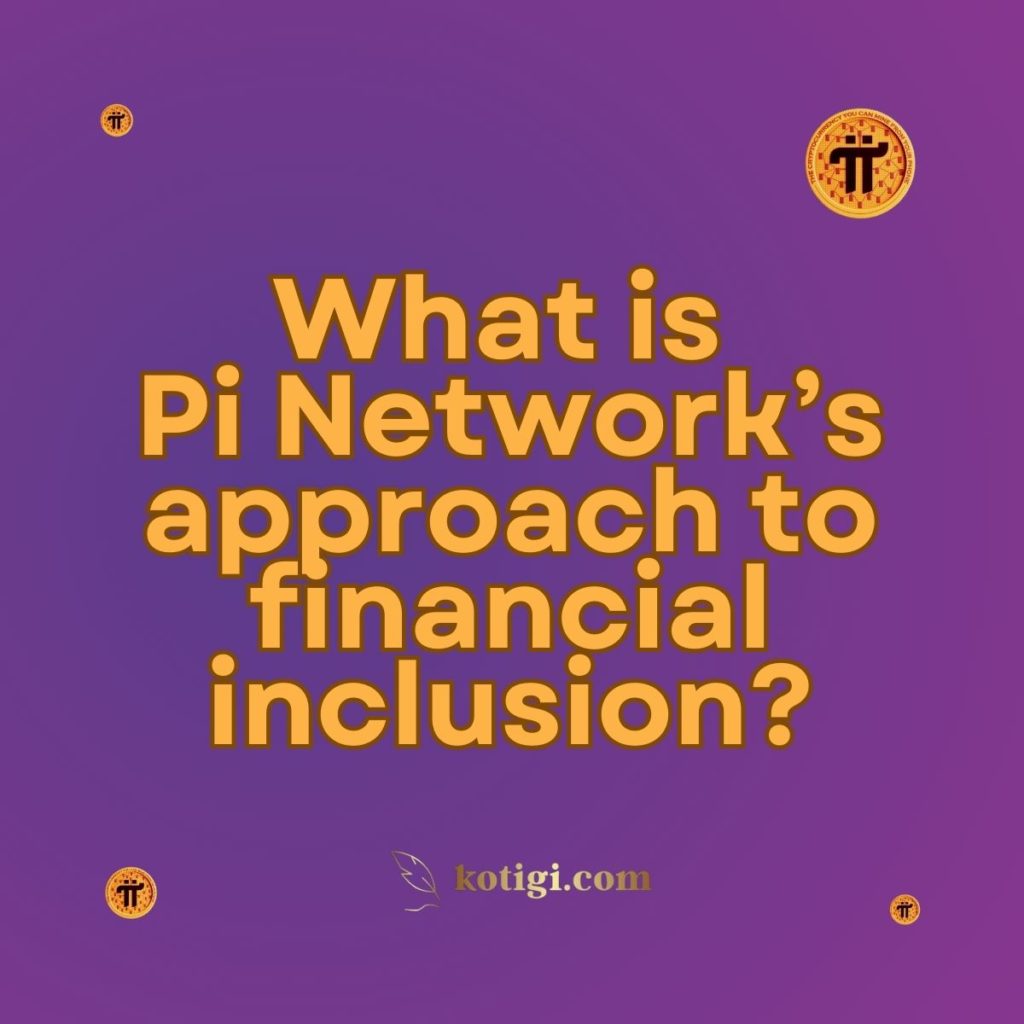
What is Pi Network’s approach to financial inclusion?
Pi Network is pioneering an innovative approach to financial inclusion, aiming to bridge the gap between the unbanked and the global cryptocurrency ecosystem. By enabling mining through mobile phones, Pi Network makes cryptocurrency accessible to a broader audience, including those in underserved regions. This post explores how Pi Network leverages technology, education, and partnerships to make a significant impact on financial inclusion, while also addressing the challenges and criticisms it faces.
Introduction
Financial inclusion remains one of the most significant challenges in the global economy, with an estimated 1.7 billion people lacking access to traditional banking services. Cryptocurrencies have been touted as a solution to this issue, but high entry barriers, such as the need for specialized mining equipment and technical expertise, often limit participation. Pi Network offers a groundbreaking alternative by allowing anyone with a smartphone to mine Pi cryptocurrency. This mobile-first approach opens the door for millions, especially those in developing countries, to participate in the digital economy. In this article, we will examine Pi Network’s efforts to foster financial inclusion, its unique features, and the challenges it faces in achieving its ambitious goals.
1. Pi Network’s Mission for Financial Inclusion
Pi Network’s mission is centered on democratizing access to cryptocurrency. Unlike traditional cryptocurrencies that require expensive hardware and significant energy consumption to mine, Pi allows users to mine cryptocurrency using only a smartphone. This innovative approach makes Pi accessible to individuals who may lack the financial resources to participate in other cryptocurrency ecosystems. By lowering these barriers to entry, Pi Network extends the benefits of cryptocurrency to populations previously excluded from the digital financial world.
1.1 Accessible Mining
Pi Network is designed to make cryptocurrency mining accessible to a global audience, regardless of financial status or technical expertise. Traditional mining setups for cryptocurrencies like Bitcoin require high-powered computers and consume vast amounts of electricity, making them impractical for many. In contrast, Pi Network allows users to mine on their mobile devices without significant battery drainage or heavy data consumption. This feature empowers individuals in economically disadvantaged regions to participate in cryptocurrency mining, creating new opportunities for wealth generation that were previously out of reach.
1.2 Reducing Financial Barriers
The absence of expensive hardware and high energy costs in Pi mining is a significant advantage, especially for users in developing countries. Pi Network eliminates the need for upfront financial investments, which are typically required for mining Bitcoin or Ethereum. By making the process more affordable, Pi Network provides an inclusive platform where anyone with a smartphone can engage in cryptocurrency mining. This shift toward financial inclusion enables individuals who are excluded from traditional financial systems to have a stake in the digital economy, opening up new pathways for financial independence.
1.3 Empowering Underbanked Populations
Pi Network holds immense potential for populations that are underbanked or entirely unbanked. In many developing countries, access to financial services is limited, leaving large portions of the population unable to participate in the broader economy. However, many of these individuals do have access to smartphones, which enables them to engage with Pi Network and earn Pi. As the network grows and Pi’s value becomes recognized, these underbanked populations can potentially use Pi as an alternative to traditional financial systems, gaining access to digital financial services without needing a bank account.
2. Leveraging Mobile Technology for Inclusion
Pi Network’s mobile-first design is integral to its strategy for fostering financial inclusion. In regions where traditional banking services and desktop-based cryptocurrency mining are inaccessible, mobile phones serve as a vital tool for participation in the digital economy. By leveraging mobile technology, Pi Network brings cryptocurrency to millions of users who might otherwise be excluded from the financial system.
2.1 Mobile-First Design
Pi Network’s entire mining process revolves around mobile devices, making it one of the most accessible cryptocurrencies globally. The app’s user-friendly design allows individuals with no prior knowledge of blockchain or cryptocurrency to start mining Pi with just a few clicks. This eliminates the complexity often associated with setting up cryptocurrency wallets, mining rigs, or trading on exchanges. With its intuitive interface, Pi Network ensures that even those who are new to the cryptocurrency world can participate effortlessly.
2.2 Broad Accessibility
One of Pi Network’s key strengths is its low-resource design, allowing even users with low-end smartphones to mine Pi without significant strain on their device’s performance. In many developing countries, smartphones are a common tool, even in areas with limited infrastructure. Pi Network capitalizes on this widespread availability of mobile devices by offering a solution that works seamlessly on older models and in regions with unreliable internet connections. This broad accessibility makes Pi Network a practical option for users in both urban and rural areas around the world.
2.3 Offline-Friendly Features
In areas where internet connectivity is unreliable or expensive, Pi Network’s offline-friendly features are crucial. Users can initiate a mining session and continue to accumulate Pi even when their device is offline. This ensures that users in regions with limited or unstable internet access can still participate in the network without constantly being connected. By offering offline mining, Pi Network significantly broadens its reach and enables users in remote locations to contribute to and benefit from the platform.
3. Educating Users on Financial Literacy
Financial literacy is a critical component of Pi Network’s approach to financial inclusion. The platform not only provides access to cryptocurrency but also aims to educate users about the digital financial system, ensuring that they can make informed decisions about how to use their earnings and participate in the network.
3.1 In-App Educational Resources
To empower its users, Pi Network integrates educational content directly into its app. This content ranges from basic tutorials on blockchain technology to more advanced topics like decentralized finance (DeFi) and smart contracts. By providing this knowledge within the app, Pi Network helps users gain a deeper understanding of the digital financial ecosystem, which is essential for fostering financial inclusion. As users become more knowledgeable about the world of cryptocurrency, they can better utilize the opportunities presented by Pi and other digital currencies.
3.2 Community-Driven Learning
Pi Network’s community plays a pivotal role in educating new users. The platform encourages a culture of shared knowledge, where experienced users can help guide newcomers through the process of mining, securing their accounts, and understanding the value of Pi. This peer-to-peer learning model ensures that the community grows together, with users helping each other navigate the complexities of the digital economy. Community-driven learning fosters a supportive environment that promotes both individual and collective financial literacy.
3.3 Financial Empowerment
Beyond basic education, Pi Network encourages users to become more involved in the network’s infrastructure by running their own nodes and contributing to the consensus algorithm. This not only helps secure the network but also empowers users to take a more active role in the digital economy. By offering opportunities for users to contribute to the network’s development, Pi Network promotes financial empowerment and allows individuals to build valuable skills in the blockchain space.
4. Collaboration with Financial Inclusion Initiatives
Pi Network’s mission to foster financial inclusion is further supported by its collaborations with organizations and initiatives that share similar goals. These partnerships enable Pi Network to expand its reach and make a greater impact on underserved communities around the world.
4.1 Strategic Partnerships
Pi Network partners with organizations focused on financial inclusion, leveraging their expertise and resources to expand its impact. These collaborations allow Pi Network to tap into established networks and bring cryptocurrency to populations that may not have otherwise encountered it. By aligning with financial inclusion initiatives, Pi Network strengthens its ability to reach unbanked and underbanked populations, providing them with access to a new financial ecosystem.
4.2 Regional Outreach Programs
Pi Network engages in regional outreach programs to introduce its platform to communities that are most in need of financial inclusion solutions. By targeting specific regions with limited access to traditional banking, Pi Network is able to address the unique challenges faced by individuals in these areas. These outreach programs often focus on education and onboarding, helping individuals understand how they can use Pi to improve their financial situation and participate in the global economy.
4.3 Partnerships with NGOs
Non-governmental organizations (NGOs) focused on financial empowerment often collaborate with Pi Network to provide resources and support to underserved communities. These partnerships aim to equip individuals with the tools and knowledge they need to effectively utilize Pi as a means of financial growth. By working with NGOs, Pi Network ensures that its financial inclusion efforts are aligned with broader global initiatives aimed at reducing poverty and promoting economic development.
5. Empowering Economically Marginalized Communities
Pi Network’s accessibility and low entry barriers make it particularly beneficial for economically marginalized communities. By offering a way to participate in the digital economy without requiring traditional banking infrastructure, Pi Network provides these communities with a path to financial independence and economic growth.
5.1 Participation Without Traditional Barriers
Traditional financial systems often exclude economically marginalized individuals due to high fees, minimum balance requirements, or the need for identification that many people lack. Pi Network removes these barriers by allowing anyone with a smartphone to mine and earn Pi. This opens up new opportunities for individuals who have been excluded from traditional financial systems, enabling them to participate in the digital economy on their own terms.
5.2 Creating New Economic Opportunities
As users earn and accumulate Pi, they can begin to explore new economic opportunities. Whether it’s using Pi for payments, trading it within the network’s ecosystem, or starting small businesses that accept Pi, economically marginalized communities can leverage the platform to improve their financial standing. Pi Network’s model encourages entrepreneurship and economic participation, which is crucial for individuals in underserved regions.
5.3 Building Financial Independence
For many individuals in economically marginalized communities, Pi Network represents an opportunity to build financial independence. As users continue to mine and hold Pi, they can accumulate wealth outside of traditional banking systems, potentially gaining financial autonomy. Over time, this accumulation of Pi could provide individuals with a financial safety net, offering them more control over their economic future.
6. Challenges and Criticisms of Pi Network’s Financial Inclusion
Despite its many advantages, Pi Network faces several challenges and criticisms regarding its ability to deliver on its financial inclusion promises. While the platform has made significant strides, skeptics raise questions about the long-term viability and value of Pi.
6.1 Unproven Value of Pi
As of now, Pi cryptocurrency is not listed on any major exchanges, meaning that its value is largely theoretical. While the network continues to grow, the actual monetary worth of Pi remains uncertain. Critics argue that without a clear path to liquidity, Pi may struggle to deliver tangible financial benefits to its users. This uncertainty raises concerns about whether Pi can truly serve as a tool for financial inclusion in the long run.
6.2 Sustainability Concerns
Pi Network’s success depends heavily on its ability to maintain and grow its user base. Some critics question whether the platform can sustain its growth and whether its economic model is viable in the long term. As the network expands, Pi Network will need to demonstrate that it can balance growth with sustainability, ensuring that it continues to provide value to its users without overburdening its infrastructure.
6.3 Legal and Regulatory Challenges
As Pi Network grows, it will need to navigate an increasingly complex regulatory landscape. Cryptocurrencies are subject to different legal frameworks around the world, and Pi Network will need to ensure that it complies with these regulations while maintaining its commitment to financial inclusion. Legal and regulatory challenges could pose significant obstacles to the platform’s ability to operate globally, especially in regions with strict cryptocurrency regulations.
7. The Future of Pi Network in Financial Inclusion
Pi Network has the potential to make a lasting impact on financial inclusion, but its future depends on how well it addresses its current challenges and continues to grow. If Pi Network can overcome these obstacles, it may emerge as a major player in the global effort to expand access to financial services.
7.1 Plans for Exchange Listings
One of the most anticipated developments for Pi Network is its eventual listing on cryptocurrency exchanges. This will allow users to trade Pi for other currencies, providing them with liquidity and a tangible financial asset. The success of these exchange listings will be critical in determining whether Pi can deliver on its promise of financial inclusion. A successful launch on exchanges would give users the ability to convert their Pi earnings into real-world value, making the platform more attractive to a broader audience.
7.2 Expansion of Features
As Pi Network evolves, it plans to introduce a range of new features designed to enhance its functionality and appeal to a broader user base. These features include decentralized finance (DeFi) tools, smart contracts, and other blockchain innovations that could further empower users in underserved regions. By continuously improving its platform, Pi Network aims to provide users with more ways to participate in the digital economy and benefit from the growing cryptocurrency ecosystem.
7.3 Long-Term Impact
Pi Network’s long-term impact on financial inclusion will depend on its ability to scale effectively while maintaining its core values of accessibility and inclusivity. If the platform can address its challenges and continue to grow, it has the potential to reshape how financial services are delivered in the digital age. By providing millions of people with access to cryptocurrency and the tools to participate in the global economy, Pi Network could play a pivotal role in closing the financial inclusion gap.
Conclusion
Pi Network offers a promising solution to the global challenge of financial inclusion by leveraging mobile technology, educational resources, and strategic partnerships. Its unique approach to cryptocurrency mining makes it accessible to a wide range of users, particularly those in economically marginalized communities. However, the network still faces significant challenges, including proving the value of Pi, ensuring sustainability, and navigating legal complexities. Despite these obstacles, Pi Network has the potential to make a lasting impact on financial inclusion, providing individuals with new opportunities to participate in the digital economy.
Key Takeaways
- Mobile-First Mining: Pi Network’s mobile-first approach allows users to mine cryptocurrency with smartphones, making it accessible to those who cannot afford traditional mining equipment.
- Financial Literacy Education: The platform offers in-app educational resources to help users understand cryptocurrency and participate more effectively in the digital economy.
- Partnerships for Financial Inclusion: Pi Network collaborates with organizations focused on financial inclusion, expanding its reach to underserved communities.
- Opportunities for Economic Growth: By providing access to digital currency, Pi Network creates new opportunities for entrepreneurship and financial independence in economically marginalized regions.
- Challenges and Future Growth: Pi Network faces hurdles related to the unproven value of Pi, sustainability concerns, and legal regulations, but it has the potential to reshape financial inclusion if these challenges are overcome.





